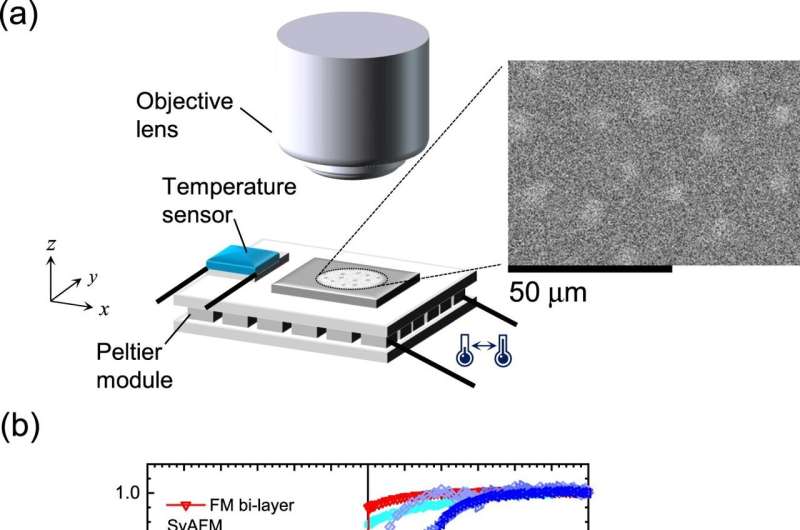This article has been reviewed according to Science X's editorial process and policies. Editors have highlighted the following attributes while ensuring the content's credibility:
fact-checked
peer-reviewed publication
proofread
Magnetic whirls pave the way for energy-efficient computing

Researchers of Johannes Gutenberg University Mainz and the University of Konstanz in Germany as well as of Tohoku University in Japan have been able to increase the diffusion of magnetic whirls, so called skyrmions, by a factor of 10. Their findings are published in the journal Nature Communications.
In today's world, our lives are unimaginable without computers. Up until now, these devices process information using primarily electrons as charge carriers, with the components themselves heating up significantly in the process. Active cooling is thus necessary, which comes with high energy costs.
Spintronics aims to solve this problem. Instead of utilizing the electron flow for information processing, it relies on their spin or their intrinsic angular momentum. This approach is expected to have a positive impact on the size, speed, and sustainability of computers or specific components.
Magnetic whirls store and process information
Science often does not simply consider the spin of an individual electron, but rather magnetic whirls composed of numerous spins. These whirls called skyrmions emerge in magnetic metallic thin layers and can be considered as two-dimensional quasi-particles. On the one hand, the whirls can be deliberately moved by applying a small electric current to the thin layers; on the other hand, they move randomly and extremely efficiently due to diffusion.
The feasibility of creating a functional computer based on skyrmions was demonstrated by a team of researchers from Johannes Gutenberg University Mainz (JGU), led by Professor Dr. Mathias Kläui, using an initial prototype. This prototype consisted of thin, stacked metallic layers, some only a few atomic layers thick.
Energy efficiency: 10-fold increase in whirl diffusion
In collaboration with the University of Konstanz and Tohoku University in Japan, researchers of Mainz University have now achieved another step towards spin-based, unconventional computing.
They were able to increase the diffusion of skyrmions by a factor of about 10 using synthetic antiferromagnets, which drastically reduces the energy consumption and increases the speed of such a potential computer. "The reduction of energy usage in electronic devices is one of the biggest challenges in fundamental research," emphasized Professor Dr. Ulrich Nowak, who led the theoretical part of the project in Konstanz.
But what is an antiferromagnet and what is it used for? Normal ferromagnets consist of many small spins, all coupled together to point in the same direction, thereby creating a large magnetic moment.
In antiferromagnets, the spins are aligned alternatingly antiparallel, i.e., a spin and its direct neighbors point in the opposite direction. As a result, there is no net magnetic moment, even though the spins remain antiferromagnetically well-ordered. Antiferromagnets have significant advantages, such as three magnitudes of faster dynamics for switching, better stability, and the potential for higher storage densities. These properties are intensively studied in multiple research projects.
Advantages of a synthetic antiferromagnet
In order to understand why these antiferromagnets are useful in this context, we need to delve a bit deeper. When skyrmions move very rapidly, an additional force component arises in ferromagnetic layers perpendicular to the direction of motion. This force component pushes the skyrmions off course.
Consequently, they end up colliding with the wall, getting stuck, and obstructing the path for others. At higher speeds, they can even be destroyed. However, it is theoretically known that this effect either does not occur in antiferromagnets or it occurs to a very limited extent.
To create such an antiferromagnet artificially, the researchers coupled two of their ferromagnetic layers in a way that the magnetization in the two layers is precisely aligned in opposite directions, canceling out their magnetic fields. This provides two advantages: They reduce the force pushing the whirls off their path and thus increase the diffusion.
"With this, we have created a synthetic antiferromagnet in which the diffusion of skyrmions is approximately ten times higher than in the individual layers," said Klaus Raab, a physicist at JGU. "This diffusion can be implemented to realize stochastic computing—a form of computing where stochastic processes like the random motion of particles are utilized."
The team of researchers investigated the effects of the compensation of the magnetic layers in addition to the influence of temperature and size of the skyrmions on diffusion and consequently on the motion of the skyrmions, both experimentally and through simulations. Intricate connections have been found.
As temperature rises, the skyrmions have more energy to diffuse faster. The heat also reduces the size of the skyrmions, which positively affects their mobility. The compensation of the vertical force component also has a positive impact on diffusion. All these effects are difficult to disentangle from each other. "The increasing diffusion seems to be attributable not only to the pure compensation of the magnetic fields but also to the associated reduction in the size of the skyrmions," summarized Raab.
More information: T. Dohi et al, Enhanced thermally-activated skyrmion diffusion with tunable effective gyrotropic force, Nature Communications, (2023). DOI: 10.1038/s41467-023-40720-0
Journal information: Nature Communications
Provided by Johannes Gutenberg-Universität Mainz





















